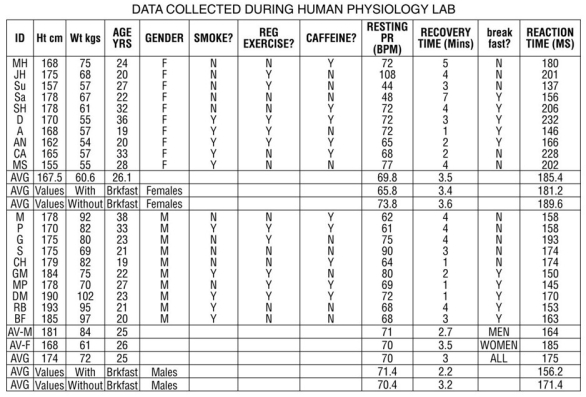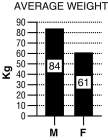Following is a table of data collected from one section of an 8 a.m.physiology lab.There were 20 students present, 10 men and 10 women.Information collected from the students included their height, weight, age, gender, and resting pulse rate.In addition, the students were surveyed to see if they smoked cigarettes, considered themselves "regular exercisers," if they had consumed caffeine the morning of the lab, and if they had eaten breakfast that day.A "y" or "n" (yes or no) was recorded to indicate their answers.Each student did "jumping jacks" for 5 minutes and recorded the time required to regain their resting heart rate, which is listed on the table as "recovery time." Finally, each student participated in an exercise designed to measure their reaction time (in milliseconds) in catching an object dropped by a lab partner according to specified criteria.Use this table to answer the following questions.Ignore statistical problems caused by small sample size, and so on.

Table 1.3

Figure 1.3
For these questions, the data were separated and analyzed by gender.
-Refer to Table 1.3.
A.Write a hypothesis regarding gender and recovery time.
B.What is the dependent variable? What is the independent variable?
C.Create a graph using the averages from the data table.Based on these data, what do you conclude?
Definitions:
Spinal Cord
A long, thin bundle of nervous tissue and support cells that extends from the brain down the vertebral column; it is central to transmitting neural signals between the brain and the rest of the body.
Cerebrum
The largest part of the brain, responsible for higher brain functions such as thought, action, and emotion.
Corpus Callosum
The large band of neural fibers connecting the two brain hemispheres and carrying messages between them.
Cerebellum
A part of the brain located at the back of the skull, crucial for motor control, coordination, precision, and timing of movements.
Q2: Which body fluid compartment contains high levels
Q4: During intense exercise our muscles produce lactate
Q17: The best post-exercise foods for marathon runners
Q24: According to the incidence of under-weight and
Q35: End-product inhibition describes the process whereby<br>A) decreasing
Q54: You conduct an experiment on twenty 18-year-old
Q65: The _ step in the HACCP program
Q66: Because most athletes have higher vitamin and
Q68: Absorption of alcohol is slowed if you
Q127: The number of mitochondria in skeletal muscle